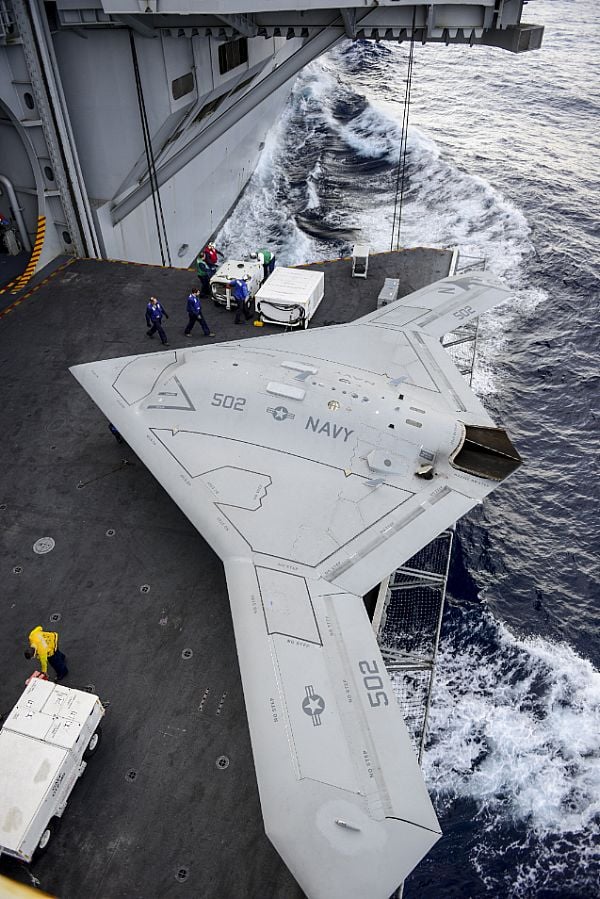
Some potential builders of the Navy’s planned Unmanned Carrier-Launched Surveillance and Strike (UCLASS) are worried a shift in focus to the requirements of the program will negate years of private research into fielding the carrier-based unmanned aerial vehicle (UAV), according to a Sunday report in Flight.
The Navy undertook a non-traditional route in acquiring UCLASS. Instead of developing a list of requirements and holding a competition early in the program, the Navy instead waited to issue an outline for the aircraft’s requirements leaving companies to develop plans for the aircraft in a vacuum using their own funds for about three years.
The final outline for the requirements (key performance parameters (KPPs)) for the aircraft were not issued to the four competitors — Lockheed Martin, Boeing, General Atomics, and Northrop Grumman — until the spring of this year.
UCLASS was developed in parallel with Northrop Grumman’s X-47B Unmanned Combat Air System demonstrator (UCAS-D). UCAS-D was designed to prove basic concepts of UAV operation on the carrier — such as takeoff, landing, navigation and aerial refueling — and inform the later UCLASS competition.
However, the changes in the KPPs for the planned $2.3 billion UCLASS program might change the fundamental nature of the aircraft.
In 2006, the UCAS program was envisioned as a stealthy platform that would greatly extend the combat range of the carrier strike group and allow aerially refueled UAVs to extend the strike range of the carrier by thousands of miles.
The new shift places the emphasis on a more efficient aircraft that would trade combat characteristics — like payload size and stealth — for an aircraft that would be able to fly its missions without refueling.
The KPPs — reported by USNI News in June — require the aircraft to fly two unrefueled orbits of 650 nautical miles or one orbit of 1,200 nautical miles around a carrier while the rest of the carrier air-wing is dormant. The requirements also call for a
“To achieve better endurance, the aircraft must have a higher aspect ratio wing, which means a longer wingspan. However, on board a carrier, the wingspan is limited to about the same length as a Northrop X-47B unmanned combat air system demonstrator. The absolute maximum is probably 70ft, which means, by necessity, weight reduction is the key to meeting the [Navy’s] new requirements,” according to the Flight report.
An unnamed industry source told the magazine the shift in focus from a stealthy UAV designed for penetrating contested enemy airspace to an aircraft more suited to hunt terrorists in controlled airspace, “leaves us is developing an alternative that meets the requirements that the navy has outlined,” Flight quoted an industry source.
The weight reduction was part of the Navy’s requirements that gave UCLASS a weapons payload of just 1,000 pounds — a quarter of the payload of the X-47B. Additionally, it is unclear if the final UCLASS proposal would allow the aircraft to be refueled mid-air.
“If you were allowed to refuel in the air then you might actually have a much broader performance spectrum,” Flight quoted an industry source. “With that gone, you’re into designing as light a weight structure as can survive the carrier environment and hold as much fuel as you can.”
The change in focus of UCLASS has raised concerns with at least some on Congress who sent a letter last week to the Secretary of Navy Ray Mabus on the acquisition program.
“We encourage you to draft a technology development request for proposal (RfP) that does not just focus on just one particular key performance parameter, but enables competition and capability tradeoffs in a spectrum of attributes such as range, payload, survivability and affordability,” wrote Chairman of the House Armed Services Seapower and Projections subcommittee Rep. Randy Forbes (R-Va.) and ranking member Rep. Mike McIntyre (D-N.C.).
The Navy plans to issue a draft RfP on the program by the end of the month and to field UCLASS in the fleet by 2020.





